Hospital Admissions Related to Infections and Disorders of the Skin and Subcutaneous Tissue in England and Wales
Abstract
1. Introduction
2. Methods
2.1. Study Sources and the Population
2.2. Statistical Analysis
3. Results
3.1. Diseases of the Skin and Subcutaneous Tissue Admission Rate by Sex
3.2. Diseases of the Skin and Subcutaneous Tissue Admission Rate by Age Group
4. Discussion
5. Conclusions
Funding
Institutional Review Board Statement
Informed Consent Statement
Data Availability Statement
Conflicts of Interest
References
- Gawkrodger, D. Dermatology: An Illustrated Colour Text, 7th ed.; Elsevier Health Sciences: Amsterdam, The Netherlands, 2020. [Google Scholar]
- Schofield, J. Skin Conditions in the UK: A Health Care Needs Assessment Paperback; University of Nottingham: Nottingham, UK, 2009. [Google Scholar]
- Tucker, R.; Duffy, J. The Role of Community Pharmacists in the Management of Skin Problems. J. Pharm. Care Health Syst. 2014, 1, 105–108. [Google Scholar] [CrossRef]
- Bickers, D.R.; Lim, H.W.; Margolis, D.; Weinstock, M.A.; Goodman, C.; Faulkner, E.; Gould, C.; Gemmen, E.; Dall, T.; American Academy of Dermatology Association; et al. The burden of skin diseases: 2004 a joint project of the American Academy of Dermatology Association and the Society for Investigative Dermatology. J. Am. Acad. Dermatol. 2006, 55, 490–500. [Google Scholar] [CrossRef] [PubMed]
- Richard, M.A.; Paul, C.; Nijsten, T.; Gisondi, P.; Salavastru, C.; Taieb, C.; Trakatelli, M.; Puig, L.; Stratigos, A.; EADV Burden of Skin Diseases Project Team. Prevalence of most common skin diseases in Europe: A population-based study. J. Eur. Acad. Dermatol. Venereol. JEADV 2022, 36, 1088–1096. [Google Scholar] [CrossRef] [PubMed]
- British Skin Foundation. Know Your Skin. 17 August 2022. Available online: https://knowyourskin.britishskinfoundation.org.uk/about/ (accessed on 13 July 2022).
- Eckert, L.; Gupta, S.; Amand, C.; Gadkari, A.; Mahajan, P.; Gelfand, J.M. Impact of atopic dermatitis on health-related quality of life and productivity in adults in the United States: An analysis using the National Health and Wellness Survey. J. Am. Acad. Dermatol. 2017, 77, 274–279. [Google Scholar] [CrossRef] [PubMed]
- Hay, R.J.; Johns, N.E.; Williams, H.C.; Bolliger, I.W.; Dellavalle, R.P.; Margolis, D.J.; Marks, R.; Naldi, L.; Weinstock, M.A.; Wulf, S.K.; et al. The global burden of skin disease in 2010: An analysis of the prevalence and impact of skin conditions. J. Investig. Dermatol. 2014, 134, 1527–1534. [Google Scholar] [CrossRef] [PubMed]
- Karimkhani, C.; Dellavalle, R.P.; Coffeng, L.E.; Flohr, C.; Hay, R.J.; Langan, S.M.; Nsoesie, E.O.; Ferrari, A.J.; Erskine, H.E.; Silverberg, J.I.; et al. Global Skin Disease Morbidity and Mortality: An Update from the Global Burden of Disease Study 2013. JAMA Dermatol. 2017, 153, 406–412. [Google Scholar] [CrossRef]
- Arnold, J.D.; Yoon, S.; Kirkorian, A.Y. The national burden of inpatient dermatology in adults. J. Am. Acad. Dermatol. 2019, 80, 425–432. [Google Scholar] [CrossRef] [PubMed]
- Naser, A.Y.; Alrawashdeh, H.M.; Alwafi, H.; AbuAlhommos, A.K.; Jalal, Z.; Paudyal, V.; Alsairafi, Z.K.; Salawati, E.M.; Samannodi, M.; Sweiss, K.; et al. Hospital Admission Trends Due to Viral Infections Characterised by Skin and Mucous Membrane Lesions in the Past Two Decades in England and Wales: An Ecological Study. Int. J. Environ. Res. Public Health 2021, 18, 11649. [Google Scholar] [CrossRef] [PubMed]
- Schofield, J.K.; Fleming, D.; Grindlay, D.; Williams, H. Skin conditions are the commonest new reason people present to general practitioners in England and Wales. Br. J. Dermatol. 2011, 165, 1044–1050. [Google Scholar] [CrossRef] [PubMed]
- Alanazi, A.F.; Naser, A.Y.; Pakan, P.; Alanazi, A.F.; Alanazi, A.A.A.; Alsairafi, Z.K.; Alsaleh, F.M. Trends of Hospital Admissions Due to Congenital Anomalies in England and Wales between 1999 and 2019: An Ecological Study. Int. J. Environ. Res. Public Health 2021, 18, 11808. [Google Scholar] [CrossRef] [PubMed]
- Al-Daghastani, T.; Naser, A.Y. Hospital admission profile related to poisoning by, adverse effect of and underdosing of psychotropic drugs in England and Wales: An ecological study. Saudi Pharm. J. 2022, 30, 1262–1272. [Google Scholar] [CrossRef]
- Alrawashdeh, H.M.; Naser, A.Y.; Alwafi, H.; AbuAlhommos, A.K.; Jalal, Z.; Paudyal, V.; Abdulmannan, D.M.; Hassanin, F.F.; Hemmo, S.I.; Al Sarireh, F. Trends in Hospital Admission Due to Diseases of the Eye and Adnexa in the Past Two Decades in England and Wales: An Ecological Study. Int. J. Gen. Med. 2022, 15, 1097–1110. [Google Scholar] [CrossRef] [PubMed]
- Al-Shehri, H.; Dahmash, D.T.; Rochow, N.; Alturki, B.; Alrajhi, D.; Alayed, F.; Alhazani, F.; Alsuhibany, H.; Naser, A.Y. Hospital Admission Profile of Neonates for Conditions Originating in the Perinatal Period in England and Wales between 1999–2020: An Ecological Study. Int. J. Gen. Med. 2022, 15, 1973–1984. [Google Scholar] [CrossRef]
- Hemmo, S.; Naser, A.; Alwafi, H.; Mansour, M.; Alanazi, A.; Jalal, Z.; Alsairafi, Z.; Paudyal, V.; Alomari, E.; Al-Momani, H.; et al. Hospital Admissions Due to Ischemic Heart Diseases and Prescriptions of Cardiovascular Diseases Medications in England and Wales in the Past Two Decades. Int. J. Environ. Res. Public Health 2021, 18, 7041. [Google Scholar] [CrossRef] [PubMed]
- Naser, A.Y.; Alwafi, H.; Hemmo, S.I.; Alrawashdeh, H.M.; Alqahtani, J.S.; Alghamdi, S.M.; Ali, M.K.M. Trends in Hospital Admissions Due to Neoplasms in England and Wales between 1999 and 2019: An Ecological Study. Int. J. Environ. Res. Public Health 2022, 19, 8054. [Google Scholar] [CrossRef] [PubMed]
- Naser, A.Y.; Dahmash, E.Z.; Al-Daghastani, T.; Alwafi, H.; Abu Hamdah, S.; Alsairafi, Z.K.; Alsaleh, F.M. An Ecological Analysis of Hospitalization Patterns for Diseases of the Nervous System in England and Wales over the Last 20 Years. Healthcare 2022, 10, 1670. [Google Scholar] [CrossRef] [PubMed]
- Naser, A.Y.; Mansour, M.M.; Alanazi, A.F.R.; Sabha, O.; Alwafi, H.; Jalal, Z.; Paudyal, V.; Dairi, M.S.; Salawati, E.M.; Alqahtan, J.S.; et al. Hospital admission trends due to respiratory diseases in England and Wales between 1999 and 2019: An ecologic study. BMC Pulm. Med. 2021, 21, 356. [Google Scholar] [CrossRef] [PubMed]
- Naser, A.Y.; Wang, Q.; Wong, L.Y.L.; Ilomaki, J.; Bell, J.S.; Fang, G.; Wong, I.C.K.; Wei, L. Hospital Admissions due to Dysglycaemia and Prescriptions of Antidiabetic Medications in England and Wales: An Ecological Study. Diabetes Ther. 2017, 9, 153–163. [Google Scholar] [CrossRef] [PubMed]
- Sweiss, K.; Naser, A.Y.; Alrawashdeh, H.M.; Alharazneh, A. Hospital admissions due to vasomotor and allergic rhinitis in England and Wales between 1999 and 2019: An ecological study. Ir. J. Med Sci. 2022, 1–7. [Google Scholar] [CrossRef] [PubMed]
- Sweiss, K.; Naser, A.Y.; Samannodi, M.; Alwafi, H. Hospital admissions due to infectious and parasitic diseases in England and Wales between 1999 and 2019: An ecological study. BMC Infect. Dis. 2022, 22, 398. [Google Scholar] [CrossRef] [PubMed]
- Health and Social Care Information Centre (HSCIC). Hospital Episode Statistics (HES). Available online: https://digital.nhs.uk/data-and-information/data-tools-and-services/data-services/hospital-episode-statistics (accessed on 13 July 2022).
- NHS Wales Informatics Service. PEDW Data Online. Available online: https://nwis.nhs.wales/information-services/welsh-data-hub/pedw-data-online/ (accessed on 13 July 2022).
- Kaye, K.S.; Patel, D.A.; Stephens, J.M.; Khachatryan, A.; Patel, A.; Johnson, K. Rising United States Hospital Admissions for Acute Bacterial Skin and Skin Structure Infections: Recent Trends and Economic Impact. PLoS ONE 2015, 10, e0143276. [Google Scholar] [CrossRef] [PubMed]
- Office for National Statistics. Population and Household Estimates, England and Wales: Census 2021. 4 September 2022. Available online: https://www.ons.gov.uk/peoplepopulationandcommunity/populationandmigration/populationestimates/bulletins/populationandhouseholdestimatesenglandandwales/census2021 (accessed on 13 July 2022).
- World Data Atlas. The United Kingdom. 25 August 2021. 2022. Available online: https://knoema.com/atlas/United-Kingdom/topics/Demographics/Population (accessed on 13 July 2022).
- Harch, S.A.; MacMorran, E.; Tong, S.Y.; Holt, D.C.; Wilson, J.; Athan, E.; Hewagama, S. High burden of complicated skin and soft tissue infections in the Indigenous population of Central Australia due to dominant Panton Valentine leucocidin clones ST93-MRSA and CC121-MSSA. BMC Infect. Dis. 2017, 17, 405. [Google Scholar] [CrossRef] [PubMed]
- Miller, L.G.; Eisenberg, D.F.; Liu, H.; Chang, C.-L.; Wang, Y.; Luthra, R.; Wallace, A.E.; Fang, C.; Singer, J.; Suaya, J.A. Incidence of skin and soft tissue infections in ambulatory and inpatient settings, 2005–2010. BMC Infect. Dis. 2015, 15, 362. [Google Scholar] [CrossRef] [PubMed]
- O’Sullivan, C.E.; Baker, M.G.; Zhang, J. Increasing hospitalizations for serious skin infections in New Zealand children, 1990–2007. Epidemiol. Infect. 2011, 139, 1794–1804. [Google Scholar] [CrossRef]
- Thean, L.J.; Jenney, A.; Engelman, D.; Romani, L.; Wand, H.; Mudaliar, J.; Paka, J.; Cua, T.; Taole, S.; Sahukhan, A.; et al. Hospital admissions for skin and soft tissue infections in a population with endemic scabies: A prospective study in Fiji, 2018–2019. PLoS Negl. Trop. Dis. 2020, 14, e0008887. [Google Scholar] [CrossRef]
- Edelsberg, J.; Taneja, C.; Zervos, M.; Haque, N.; Moore, C.; Reyes, K.; Al, J.E.E.; Jiang, J.; Oster, G. Trends in US Hospital Admissions for Skin and Soft Tissue Infections. Emerg. Infect. Dis. 2009, 15, 1516–1518. [Google Scholar] [CrossRef]
- Hersh, A.L.; Chambers, H.F.; Maselli, J.H.; Gonzales, R. National Trends in Ambulatory Visits and Antibiotic Prescribing for Skin and Soft-Tissue Infections. Arch. Intern. Med. 2008, 168, 1585–1591. [Google Scholar] [CrossRef]
- Pallin, D.J.; Egan, D.J.; Pelletier, A.J.; Espinola, J.A.; Hooper, D.C.; Camargo, C. Increased US Emergency Department Visits for Skin and Soft Tissue Infections, and Changes in Antibiotic Choices, During the Emergence of Community-Associated Methicillin-Resistant Staphylococcus aureus. Ann. Emerg. Med. 2008, 51, 291–298. [Google Scholar] [CrossRef]
- Hunt, D. Assessing and Reducing the Burden of Serious Skin Infections in Children and Young People in the Greater Wellington Region; Capital and Coast DHB, Hutt Valley DHB, Regional Public Health: Wellington, New Zealand, 2004. [Google Scholar]
- Baddour, L.M.; Bisno, A.L. Infection of the Skin and Subcutaneous Tissue. In Infections of the Head and Neck; Schlossberg, D., Ed.; Springer: New York, NY, USA, 1987; pp. 1–13. [Google Scholar]
- Chen, W.; Mempel, M.; Traidl-Hofmann, C.; Al Khusaei, S.; Ring, J. Gender aspects in skin diseases. J. Eur. Acad. Dermatol. Venereol. JEADV 2010, 24, 1378–1385. [Google Scholar] [CrossRef]
- Interagency Task Force on Antimicrobial Resistance. In A Public Health Plan to Combat Antimicrobial Resistance; Centre for Diseases Control and Prevention: Atlanta, GA, USA, 2018; pp. 1–34.
- Quirke, M.; Ayoub, F.; McCabe, A.; Boland, F.; Smith, B.; O’Sullivan, R.; Wakai, A. Risk factors for nonpurulent leg cellulitis: A systematic review and meta-analysis. Br. J. Dermatol. 2017, 177, 382–394. [Google Scholar] [CrossRef]
- Stevens, D.L.; Bisno, A.L.; Chambers, H.F.; Dellinger, E.P.; Goldstein, E.J.; Gorbach, S.L.; Hirschmann, J.V.; Kaplan, S.L.; Montoya, J.G.; Wade, J.C.; et al. Practice guidelines for the diagnosis and management of skin and soft tissue infections: 2014 update by the Infectious Diseases Society of America. Clin. Infect. Dis. Off. Publ. Infect. Dis. Soc. Am. 2014, 59, e10–e52. [Google Scholar] [CrossRef] [PubMed]
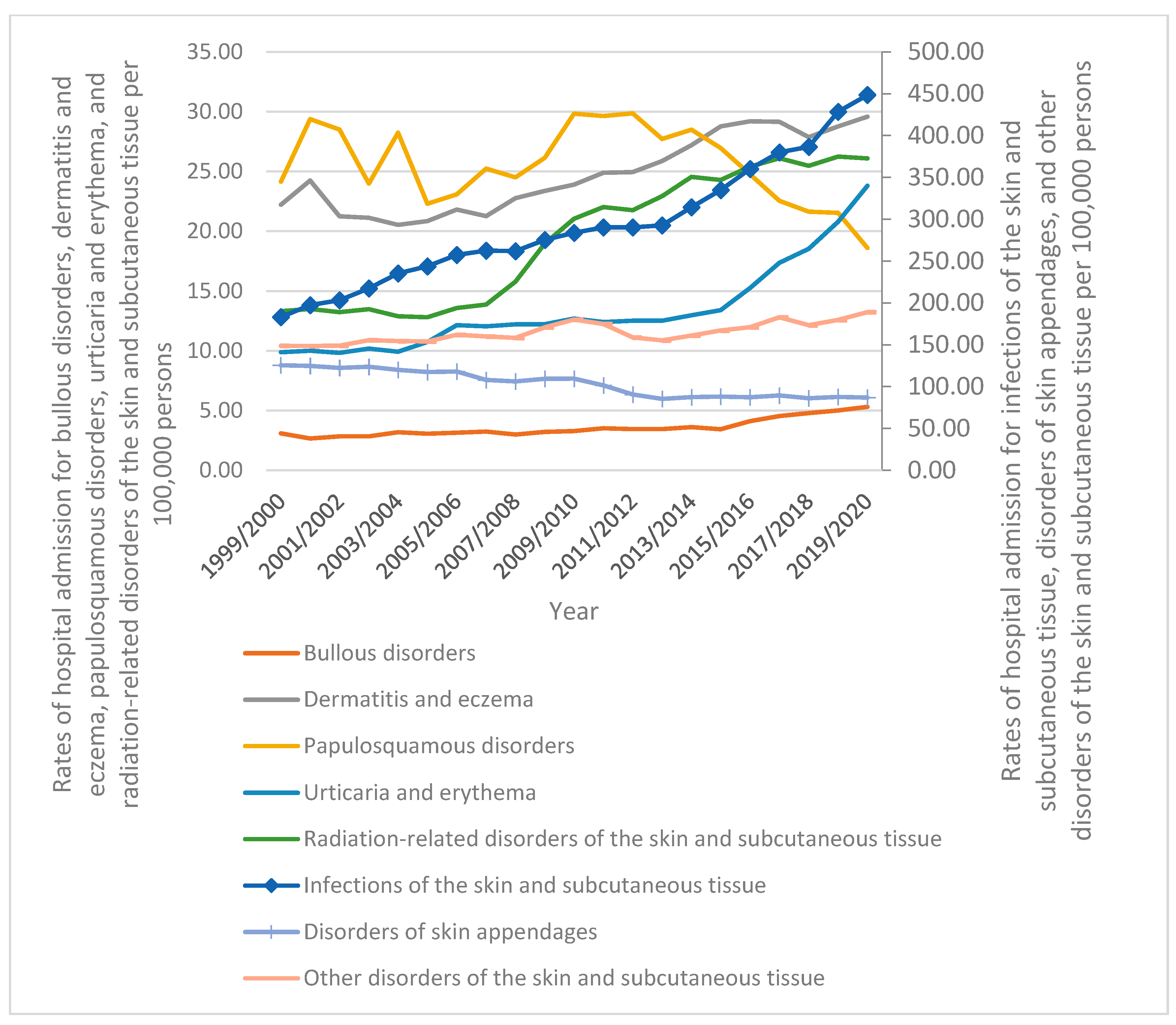

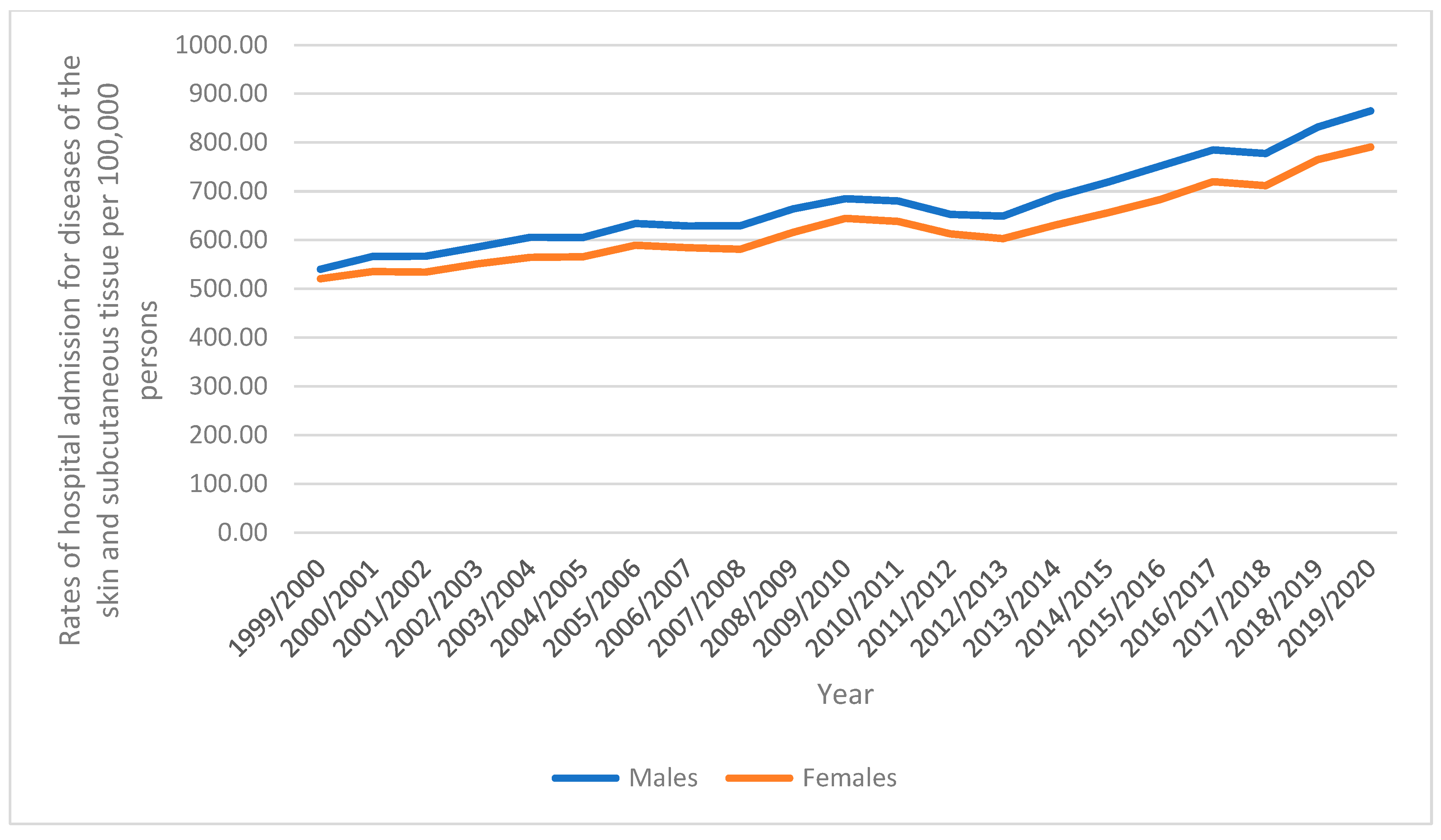
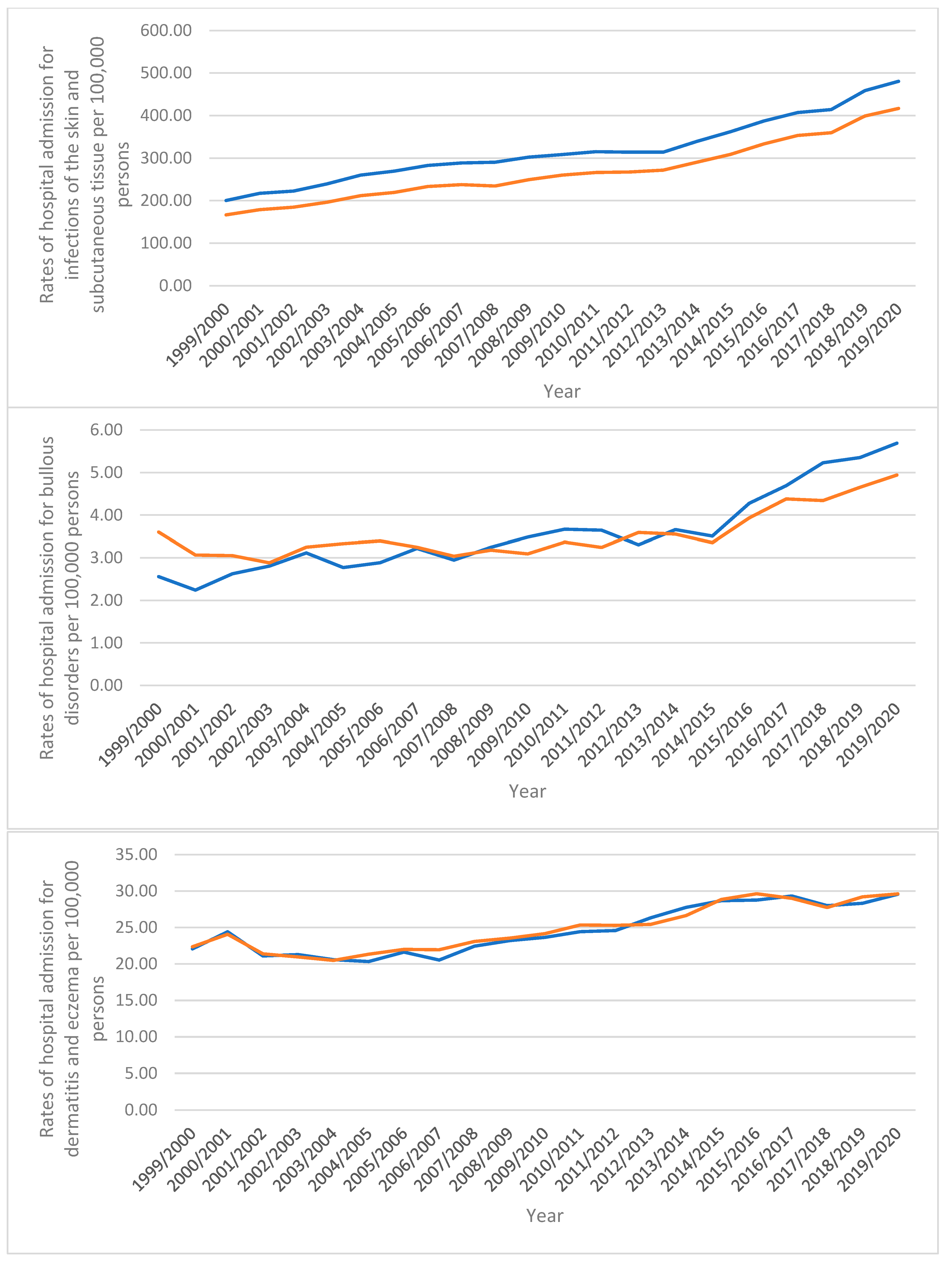
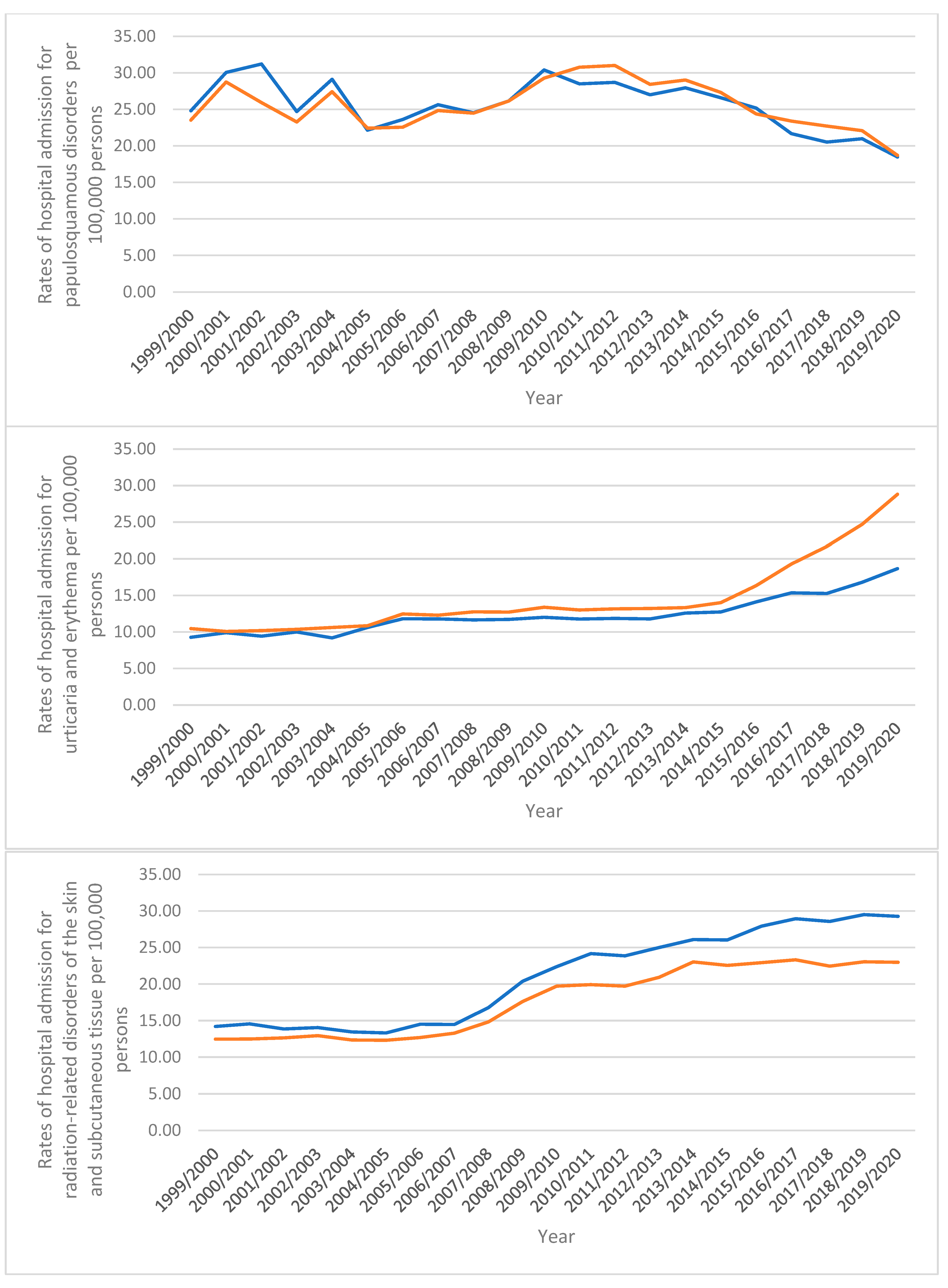
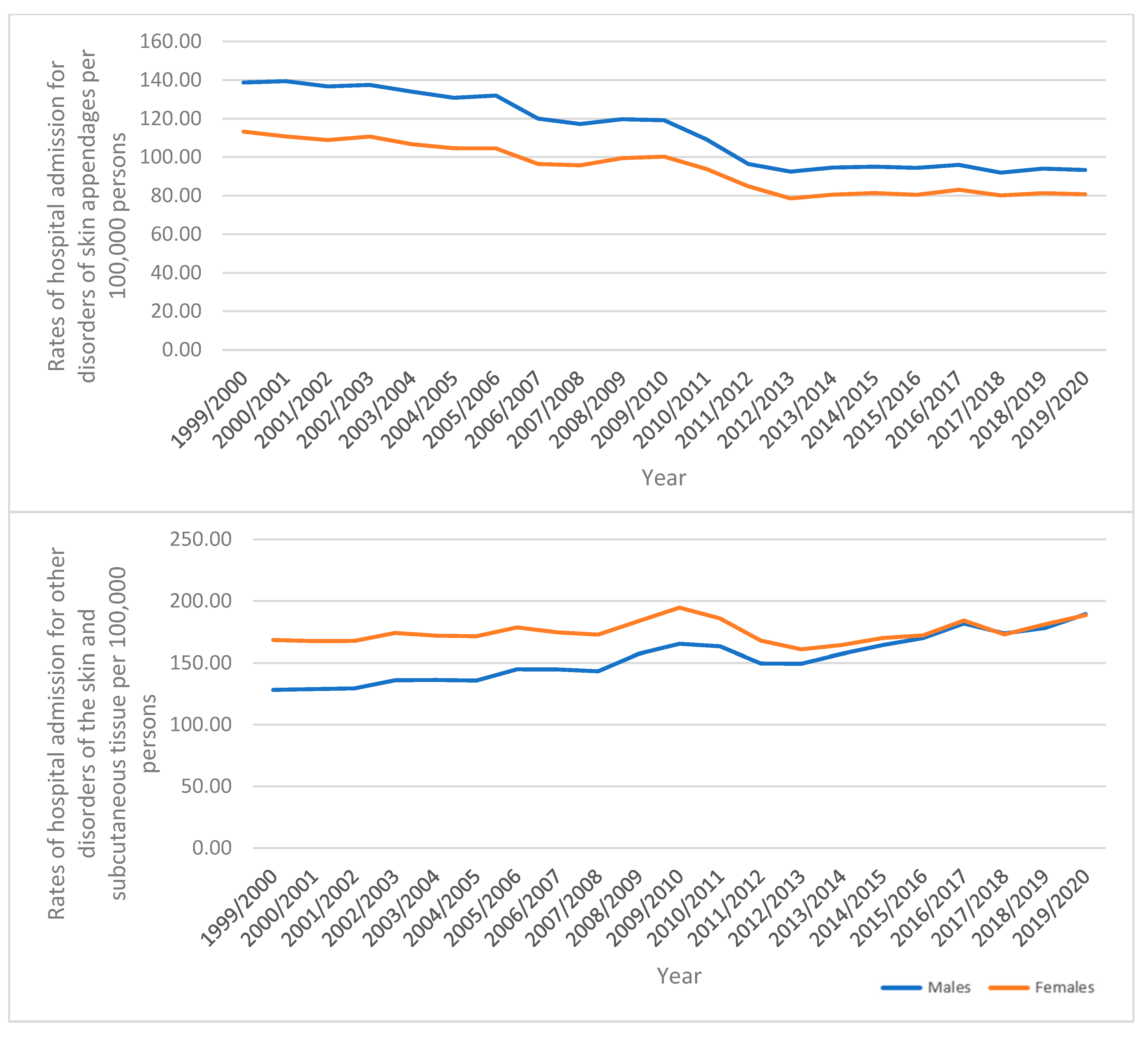
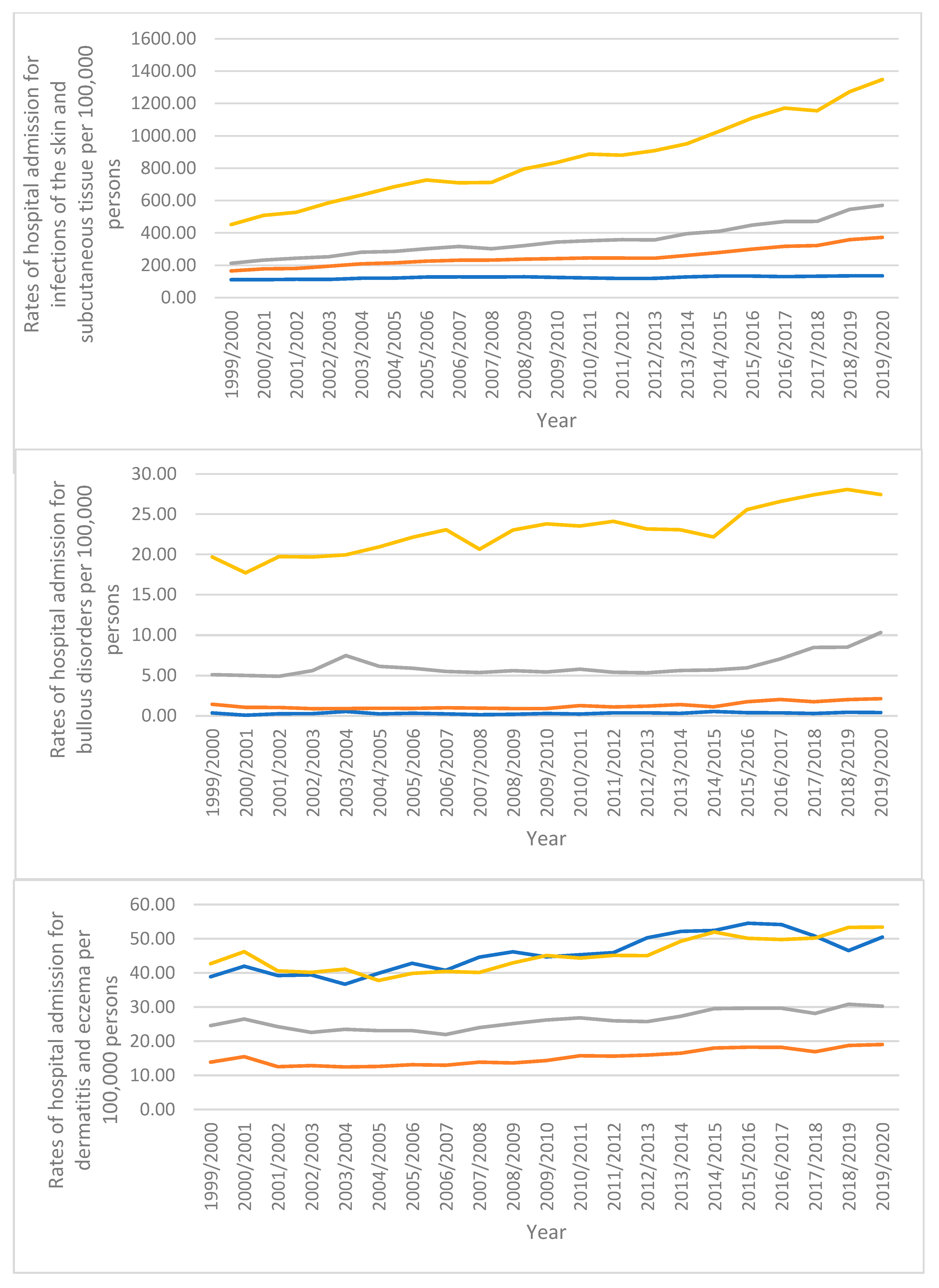
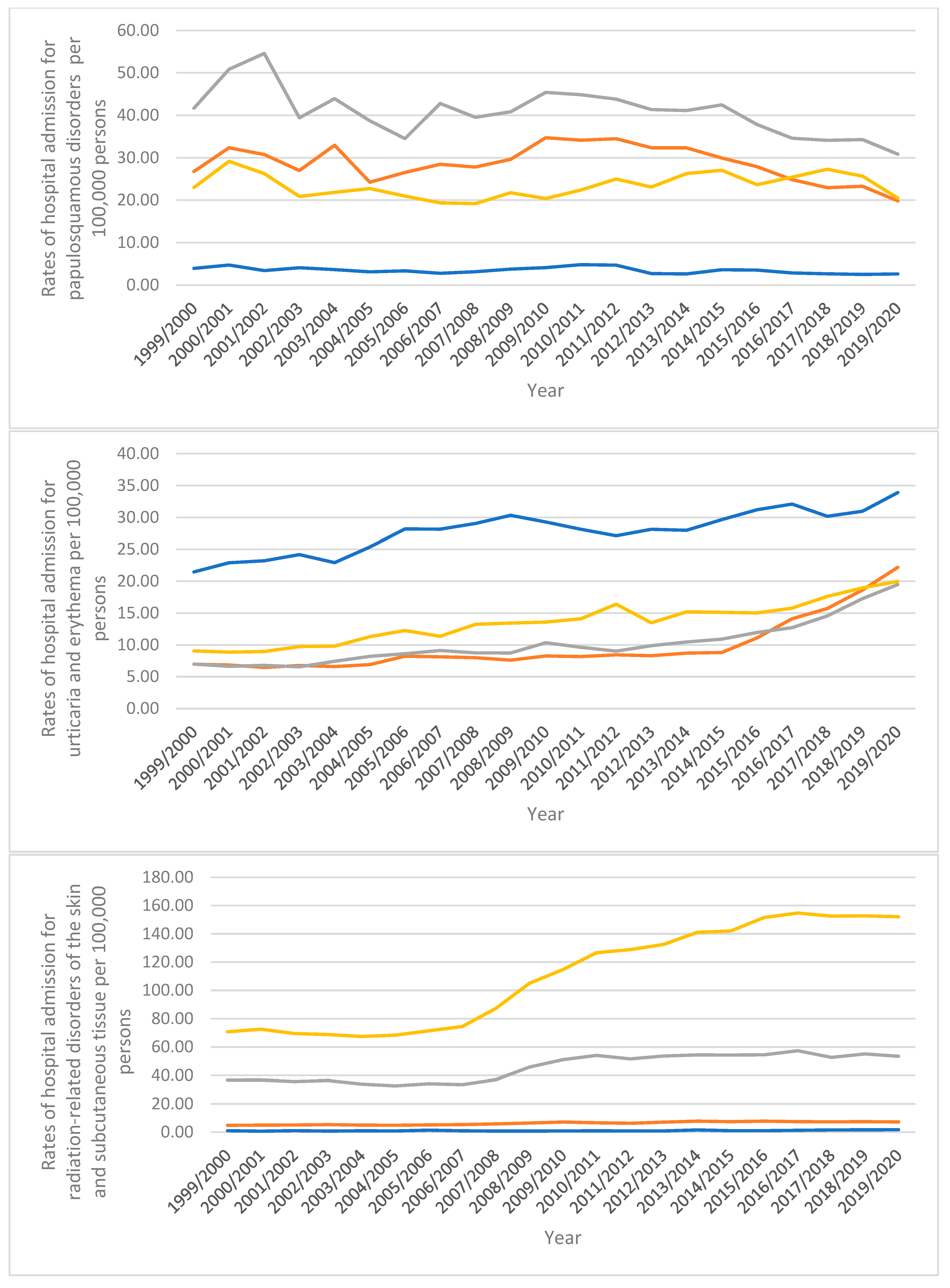
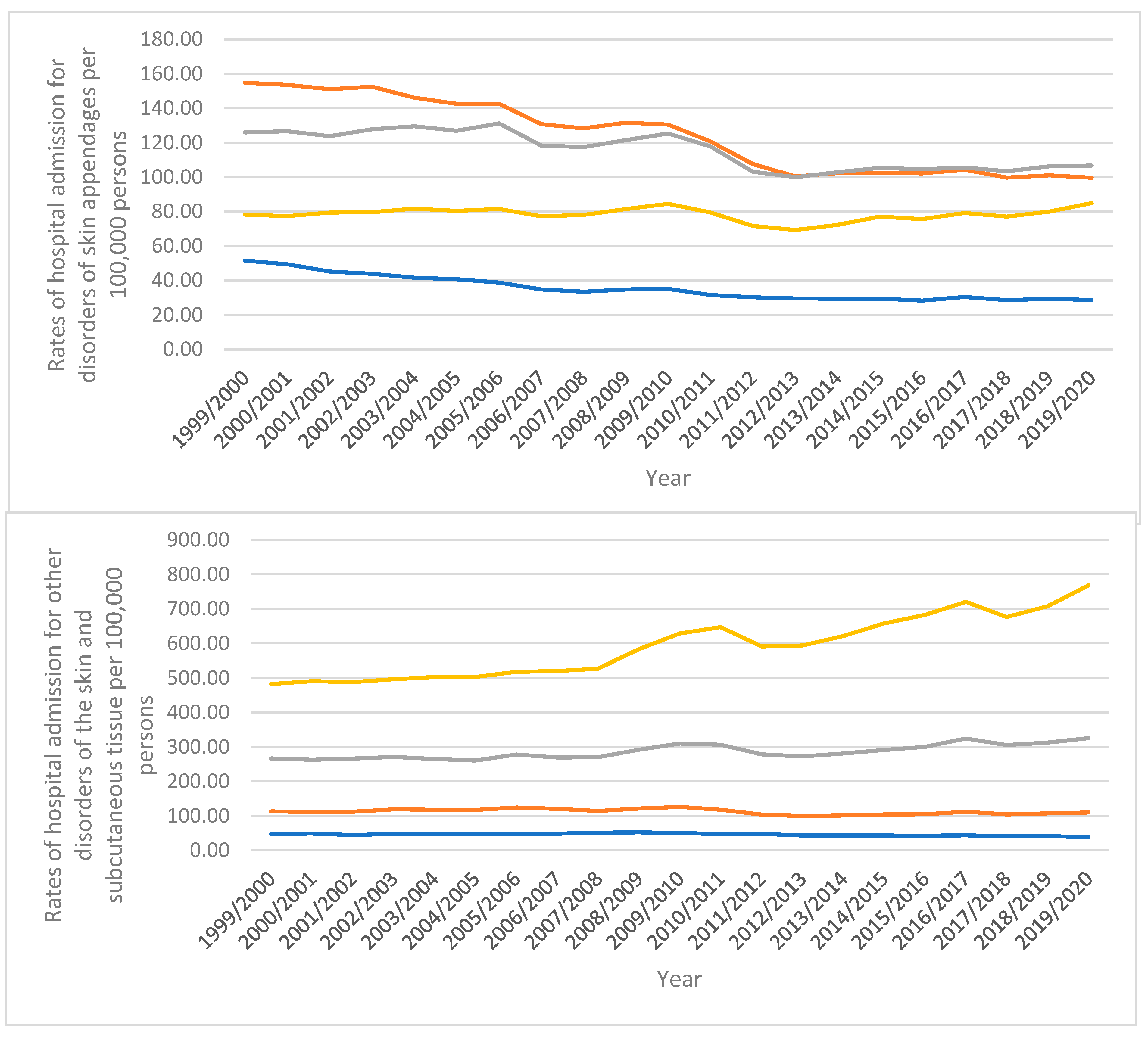
| ICD Code | Description | Percentage from Total Number of Admissions |
|---|---|---|
| L00–L08 | Infections of the skin and subcutaneous tissue (staphylococcal scalded skin syndrome, impetigo, cutaneous abscess, furuncle and carbuncle, cellulitis and acute lymphangitis, acute lymphadenitis, pilonidal cyst and sinus, and other local infections of skin and subcutaneous tissue). | 45.5% |
| L80–L99 | Other disorders of the skin and subcutaneous tissue (vitiligo, other disorders of pigmentation, seborrheic keratosis, acanthosis nigricans, corns and callosities, other epidermal thickening, keratoderma, transepidermal elimination disorders, pyoderma gangrenosum, pressure ulcer, atrophic disorders of skin, hypertrophic disorders of skin, granulomatous disorders of skin and subcutaneous tissue, lupus erythematosus, other localized connective tissue disorders, vasculitis limited to skin, and non-pressure chronic ulcer of lower limb) | 25.3% |
| L60–L75 | Disorders of skin appendages (nail disorders, nail disorders in diseases classified elsewhere, alopecia areata, androgenic alopecia, other nonscarring hair loss, cicatricial alopecia [scarring hair loss], hair color and hair shaft abnormalities, hypertrichosis, acne, rosacea, follicular cysts of skin and subcutaneous tissue, other follicular disorders, eccrine sweat disorders, and apocrine sweat disorders) | 15.8% |
| L40–L45 | Papulosquamous disorders (psoriasis, parapsoriasis, pityriasis rosea, and lichen planu) | 3.9% |
| L20–L30 | Dermatitis and eczema (atopic dermatitis, seborrheic dermatitis, diaper dermatitis, allergic contact dermatitis, irritant contact dermatitis, unspecified contact dermatitis, exfoliative dermatitis, dermatitis due to substances taken internally, lichen simplex chronicus and prurigo, and pruritus) | 3.8% |
| L55–L59 | Radiation-related disorders of the skin and subcutaneous tissue | 3.0% |
| L50–L54 | Urticaria and erythema (exfoliation due to erythematous conditions according to extent of body surface involved, urticaria, erythema multiforme, erythema nodosum, and oher erythematous conditions) | 2.1% |
| L10–L14 | Bullous disorders (pemphigus, other acantholytic disorders, and pemphigoid) | 0.6% |
| Diseases | Rate of Diseases in 1999 per 100,000 Persons (95% CI) | Rate of Diseases in 2020 per 100,000 Persons (95% CI) | Percentage Change from 1999 to 2020 |
|---|---|---|---|
| Infections of the skin and subcutaneous tissue | 183.14 (181.97–184.30) | 448.51 (446.81–450.20) | 144.9% |
| Bullous disorders | 3.09 (2.94–3.24) | 5.32 (5.13–5.50) | 71.9% |
| Dermatitis and eczema | 22.21 (21.81–22.62) | 29.59 (29.15–30.02) | 33.2% |
| Papulosquamous disorders | 24.14 (23.72–24.56) | 18.60 (18.25–18.94) | −23.0% |
| Urticaria and erythema | 9.88 (9.61–10.15) | 23.80 (23.41–24.19) | 140.9% |
| Radiation-related disorders of the skin and subcutaneous tissue | 13.31 (13.00–13.63) | 26.09 (25.68–26.50) | 96.0% |
| Disorders of skin appendages | 125.66 (124.70–126.62) | 86.97 (86.23–87.72) | −30.8% |
| Other disorders of the skin and subcutaneous tissue | 148.80 (147.75–149.85) | 189.05 (187.95–190.15) | 27.1% |
Publisher’s Note: MDPI stays neutral with regard to jurisdictional claims in published maps and institutional affiliations. |
© 2022 by the author. Licensee MDPI, Basel, Switzerland. This article is an open access article distributed under the terms and conditions of the Creative Commons Attribution (CC BY) license (https://creativecommons.org/licenses/by/4.0/).
Share and Cite
Samannodi, M. Hospital Admissions Related to Infections and Disorders of the Skin and Subcutaneous Tissue in England and Wales. Healthcare 2022, 10, 2028. https://doi.org/10.3390/healthcare10102028
Samannodi M. Hospital Admissions Related to Infections and Disorders of the Skin and Subcutaneous Tissue in England and Wales. Healthcare. 2022; 10(10):2028. https://doi.org/10.3390/healthcare10102028
Chicago/Turabian StyleSamannodi, Mohammed. 2022. "Hospital Admissions Related to Infections and Disorders of the Skin and Subcutaneous Tissue in England and Wales" Healthcare 10, no. 10: 2028. https://doi.org/10.3390/healthcare10102028
APA StyleSamannodi, M. (2022). Hospital Admissions Related to Infections and Disorders of the Skin and Subcutaneous Tissue in England and Wales. Healthcare, 10(10), 2028. https://doi.org/10.3390/healthcare10102028





